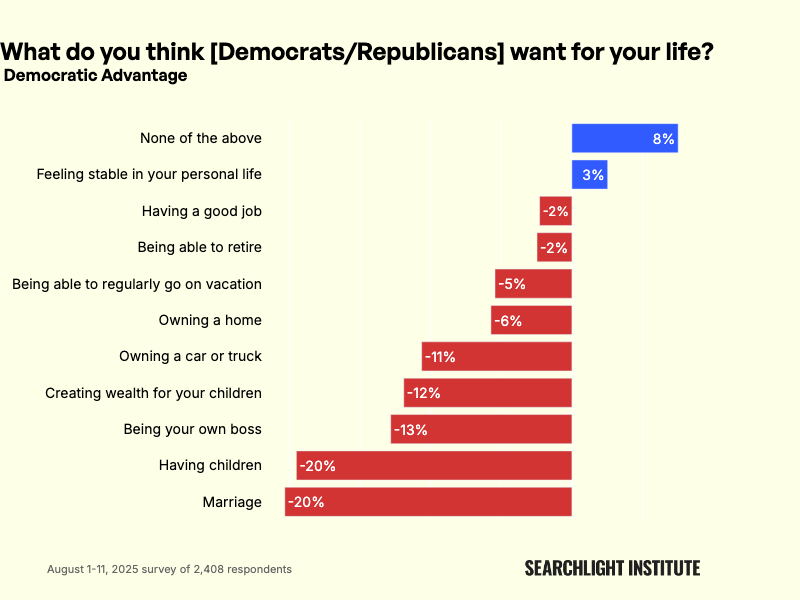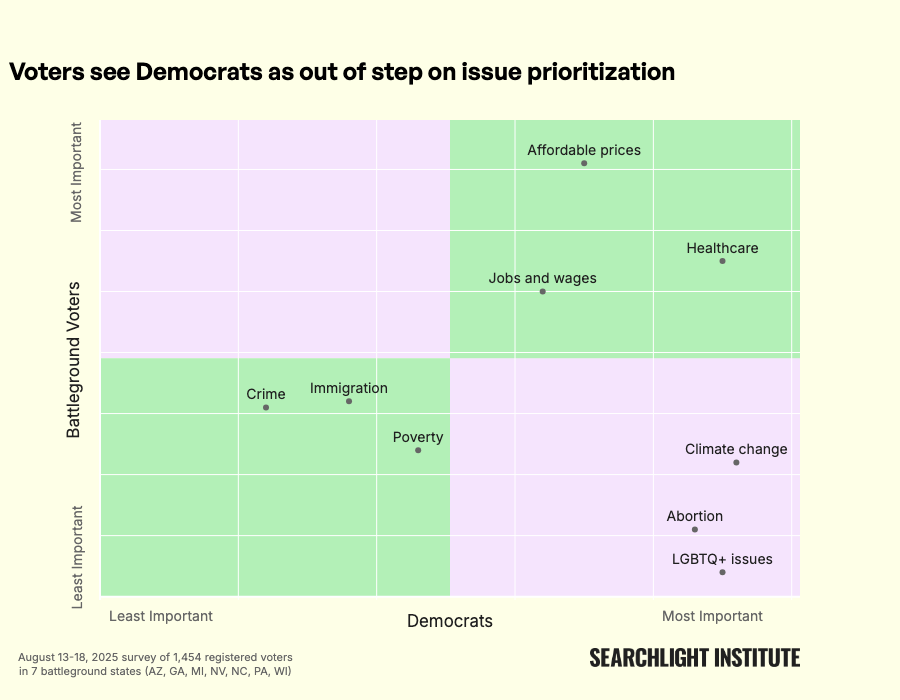The chart that should keep Democrats up at night
At Searchlight, we’ve taken to calling this the “doomsday” chart. The news doesn’t start off great—with voters indicating they don’t believe Democrats want any of the things we offered as common topics of everyday life. It gets worse when voters are asked which party cares more about their ability to retire.
To those of the liberal persuasion, the Republican advantage here should be chilling.
Democrats are the party of Social Security. Democrats are the party of Medicare.
Democrats have made the protection of both programs mainstays of their platform for as long as most of us can remember.
The outlook gets worse and worse for Democrats the further down the list you travel. The picture that’s painted is one in which voters increasingly see Republicans as the party best suited to helping them build lives of material prosperity and personal achievement.
When a voter is unconvinced that a political party wants “good” things for them, even the best crafted policies or messages quickly run up against a hard brick wall of resistance.
Taken together with our previous research that showed Democrats being perceived as out of step on the issues voters prioritize, you quickly see a massive problem for Democrats as they cast about for what to do next.
This data doesn’t mean that Democrats should abandon their values or suddenly jettison parts of their coalition. (It should be noted that Republicans have issues of their own in this regard.) But it does present Democrats with an opportunity to think creatively about how they convey their policy priorities.
This is a dynamic moment. There’s a real chance for Democrats to embrace new policy solutions around reforming the social safety net, providing more upward mobility for people, and supporting the everyday aspirations of Americans. Political leaders should look for opportunities to listen to what voters are prioritizing instead of pitching them on the same ideas they’ve heard cycle after cycle.
The doomsday scenario doesn’t have to be a permanent reality, but it will require Democrats to cast aside rigidity and get comfortable with being uncomfortable.
To explore the survey’s full dataset, read our write-up and check out the toplines and crosstabs.




True, not everyone is familiar with quadrant scatter plot charts ;) but Dems should start to speak more about the lower quadrant issues if they want to get centrist and pull a few repub votes as well. Crime, immigration and poverty. Crime = be tough, but stop the militarization of our community police. Immigration = secure the border, but honor the 3rd, 4th, 5th amendments. Poverty = No cash handouts rather create a modern WPA effort to train in construction skills (carpenter, plumber, electrician, HVAC, etc.) and to use those skills in a national home building program to create affordable housing (marketable, good paying skills + affordable housing = reduction in poverty).
I am so furious with the Democratic Party, which is partly to blame for the utter political insanity we face today. If the Democrats had come off their high horses about what many Americans perceived as uncontrolled open borders and out of control crime, and if the Democratic leadership recognized that emphasizing and promoting LGBQT policies and programs were an anathema to many Americans, we might not be dealing with the Trump dictatorship today.
Why can't Democrats realize that most Americans want economic and social stability, strong law enforcement and punishment for crime, tough but fair immigration policies which emphasize the importance of legal immigration and strong border control—all coupled with a strong sense of social order and a simple feeling that "the quality of my life is good and I feel positive about the future."
I submit that, in this inherently conservative country, many Americans have little to no tolerance for the promotion of what they perceive as culturally offensive positions that do nothing for them (and which lead them to vote against Democrats). Beyond that, talking in plain and straightforward language, while focusing on critical issues, seems beyond the capacity of Democratic leaders. To those leaders, I suggest the following.
Please stop talking about "oligarchy." Please focus on the fact that Trump and his rich friends and supporters primarily want to help themselves, and the hell with the middle class and just about everybody else. Talk about what Democrats will do to help Americans get good jobs, buy houses and cars, and assist the middle class overall.
Please stop talking about climate change and environmental issues without linking those discussions to real economic consequences that adversely all of us—and point out specific and meaningful examples, while giving other examples of how America is strengthened economically and in so many other ways if we take reasonable steps to improve our children's lives, which includes leaving them with clean air and water, and open spaces they can enjoy and cherish (just as we do).
Please stop using the term "authoritarianism." Please start using language that most people understand, such as calling out the Trump dictatorship and his political and economic blackmail and extortion. Say what Trump really is: a dangerous and selfish thug trying to turn the United States government into his gangster organization, doing his bidding under the pretense of MAGA. Point out how the Republicans kiss this thug's ass, not for the benefit of America but for their benefit.
Please start talking about what is truly important to our country and what we can do to make it better. Show exactly how the Democrats will do that. Explain in short, simple terms how Trump and the Republicans are not only making America worse, but how they are destroying what this country stands for, which in part is freedom and opportunity. Give examples. Shout out from the rooftops. Keep beating the drum and do so with fervor and a strong willingness to fight. Take all action necessary—and then even more. Stop accepting Trump’s actions as the new normal. Point out how abnormal they are, and how they threaten all of us.
Start talking about why we need government in a country as complex and complicated as America, and what would happen without it. Focus on what government should do, which is to fundamentally provide for the safety and security of its citizens, followed by taking appropriate steps to make their lives collectively better in the least intrusive way possible, while still upholding Constitutional and fundamental moral values. Talk about creating a better and more efficient government, while recognizing that government cannot always be the final or ultimate answer to our problems.
There is a rapidly vanishing window of limited opportunity. Can the Democratic Party seize the moment and save our country?